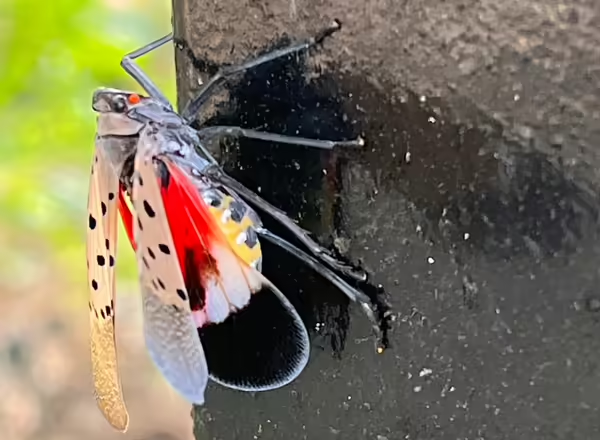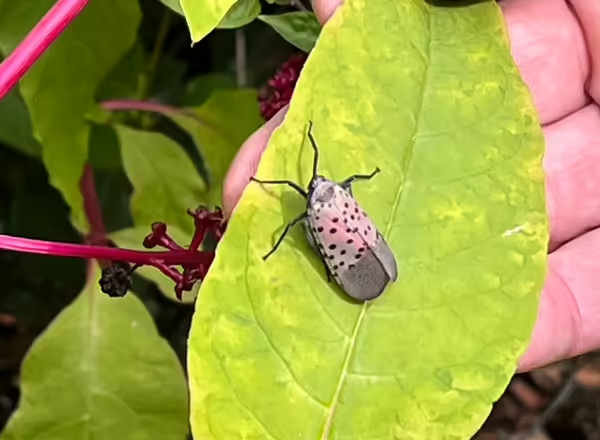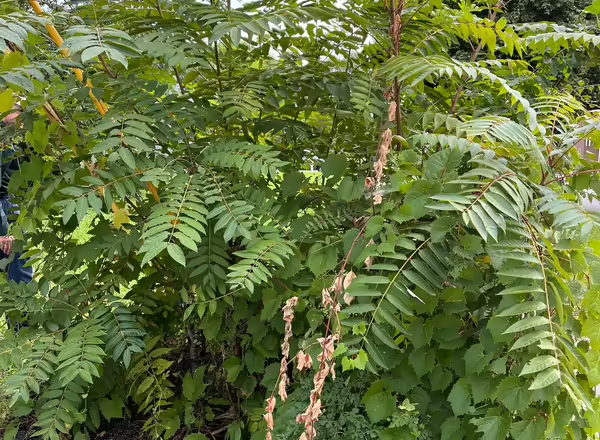
Invasive species are putting continual pressure on plants and animals in Illinois, which is only expected to intensify in the coming years. This means we all need to be vigilant for new threats and aware of their impact when new invasives arrive.
Last month, experts confirmed the arrival a new invasive species in Cook County with the first documented occurrence of spotted lanternfly (Lycorma delicatula) in Illinois. Officials across the Midwest have been monitoring for this pest since its first detection in 2014, with expectations it will spread.
“Illinois is known for having many high-risk transportation pathways, such as railroads, highways, airports and marinas, so its not overly surprising that this pest has showed up in a population center,” notes Tricia Bethke, who is The Morton Arboretum’s Forest Pest Outreach Coordinator.
Bethke, along with other experts from the Illinois Department of Agriculture, The City of Chicago Bureau of Forestry and USDA’s Animal and Plant Health Inspection Service (APHIS), have been actively involved in searches for the pest over recent weeks, as well as responding to new inquires about this alien insect.


Spotted lanternfly is a tricky pest to contain due to its habit of laying eggs masses on a variety of smooth, human-made surfaces. From railcars to campers and boats, it has a tendency to deposit eggs on things that humans move around and we can unknowingly be the vector of spread across great distances.
Word has also spread of this new infestation over recent weeks as the spotted lanternfly made headlines upon its arrival.
“The public has been more curious than alarmed, and our message of “Don’t Panic” has been a big relief,” says Bethke. Her wise words offer some solace in the face of this new threat to Illinois. It is not a time to panic, but a time to be vigilant.
Bethke reiterates her mantra from recent weeks, “See it, snap it and send it to lanterfly@illinois.edu, “ she says. “We want to document the spread by County. Cook County has been verified, so we encourage residents throughout the state to keep looking and reporting if they suspect an infestation.”
With a continual stream of new research coming from the areas of initial infestation, researchers are sharing lessons learned on the impacts of this pest, as well as management strategies. These tools have painted a clearer picture of what the arrival of spotted lanternfly may mean to new areas.

“Spotted lanternfly has a wide host range and is expected to feed on quite a few landscape plants, but its not going to wipe out your yard,” notes Bethke.
She also mentions this pest’s affinity for another non-native from the plant kingdom.
“Tree-of-heaven is its preferred food source and this presents a positive side of this particular pest, since tree-of-heaven is a problem plant.”
Bethke also noted that spotted lanternfly has shown an affinity for other species, including wild grape (Vitis spp.), willows (Salix spp.), birches(Betula spp.), and both red (Acer rubra) and silver maple (Acer saccharinum), although tree-of-heaven (Ailanthus altissima) remains its preferred host plant.
Tree-of-heaven is fierce competitor when it invades natural areas as it spreads via an aggressive root system and prolific seed production to out compete native plants. This aggressive habit has also led to extensive spread in urban areas as well, with many noting this plant as tough enough to grow in “the cracks of sidewalks”.
Dense populations of tree-of-heaven will attract spotted lanternfly and one great recommendation to limit spread of spotted lanternfly is to control tree-of-heaven now.
“Remove unwanted invasive plant material around trees and buildings,” recommends Bethke. “Spotted lanternfly is a planthopper so, when there’s nothing to hop on, the likelihood of spread diminishes greatly.”
What's next?
When asked about what the future of spotted lanternfly in Illinois, Bethke replies with a positive message.
“The future looks pretty good! We have great partnerships and communication channels and hope to get ahead of any high-level infestations. We took a team approach to identifying, documenting and managing this pest, and it worked!”, she proclaims.
“Panic levels are low, people are reporting suspicious pests and we have the tools to learn more about how to identify and control spotted lanternflies.”
If you find insects resembling spotted lanternfly, please send pictures and information to lanterfly@illinois.edu or contact your local Illinois Extension office for direct assistance.
Main image caption: Spotted lanternfly was recently spotted for the first time in Illinois. Midwestern observers have been watching for its arrival since 2014.